We model droplets.
Discover
PPBDesigner
What is PPBDesigner?
PPBDesigner is a software for modeling and simulation of discrete flow systems, such as liquid-liquid extraction columns (LLEC) with an application of detailed population balances.
It uses modern population balance solvers to discretize the internal particle coordinates, while the built-in space-time solvers are utilized to discretize the temporal-spatial domain.
Its LLEC modules (agitated and non-agitated columns) examine the effect of dispersed phase inlet and the direction of mass transfer on the column performance.
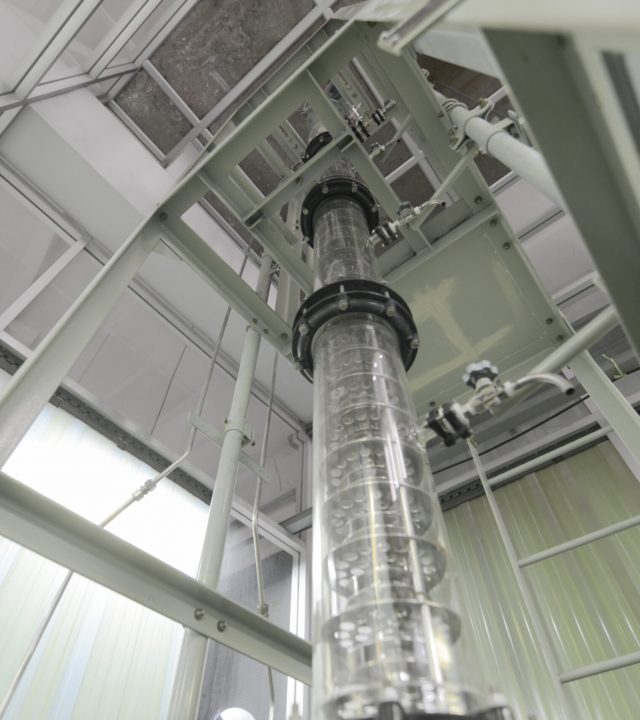
The particulate population balance framework considers the realistic character of the systems where particle motion is mainly governed by buoyancy and drag forces. The effect of turbulence, breakage, coalescence, growth, and solute transfer is built-in during the modeling process.
PPBDesigner takes these phenomena into account to bridge the gap between ideal LLEC modules and the real column performance.
It is a tool for both academia and industry practitioners to discover the different aspects of the phenomena considered in equipment design and performance.
Why use PPBDesigner?
You reduce the time invested in the early stage of development to confirm whether the unit operation is convenient for your process and whether it meets your performance requirement.
You reduce costs associated with preliminary laboratory tests by eliminating the use of pilot plants and experiments.
You get a realistic description of the coupled hydrodynamics and mass transfer phenomena in particulate processes.
PPBDesigner integrates with a process simulator
PPBDesigner is a built-in column module in DWSIM Pro, the commercial sibling of the open-source process simulator DWSIM.
PPBDesigner in DWSIM Pro is accessible online with a personal login on any device. No download and installation is required.
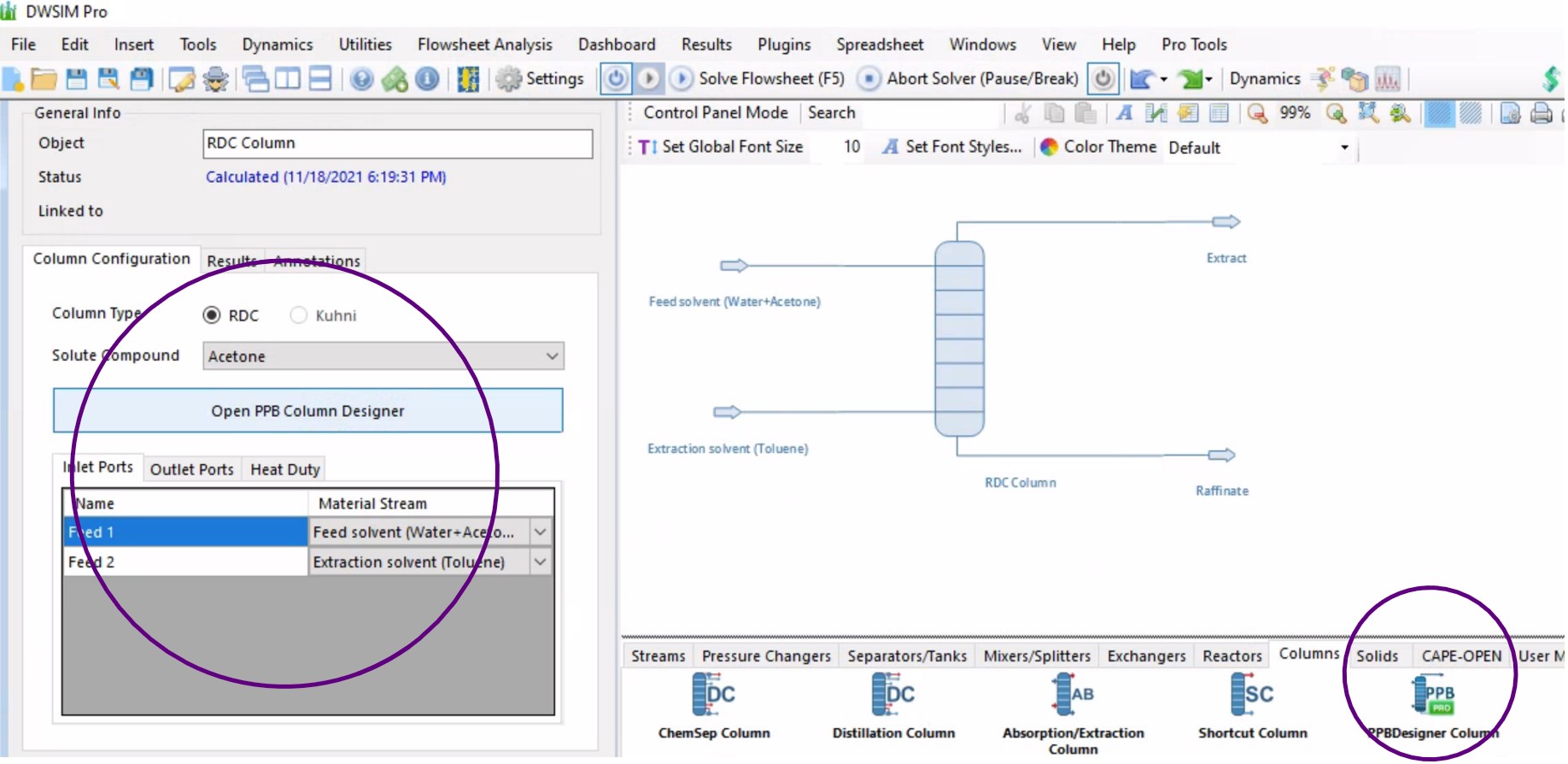
Available columns
-
RDC column
-
Kühni column
Coming soon
-
Pulsed sieve plate column
-
Pulsed packed bed
-
Spray column
-
Multi-Impeller column
-
Oil splitting reactor
-
Pulsed disc and doughnut column
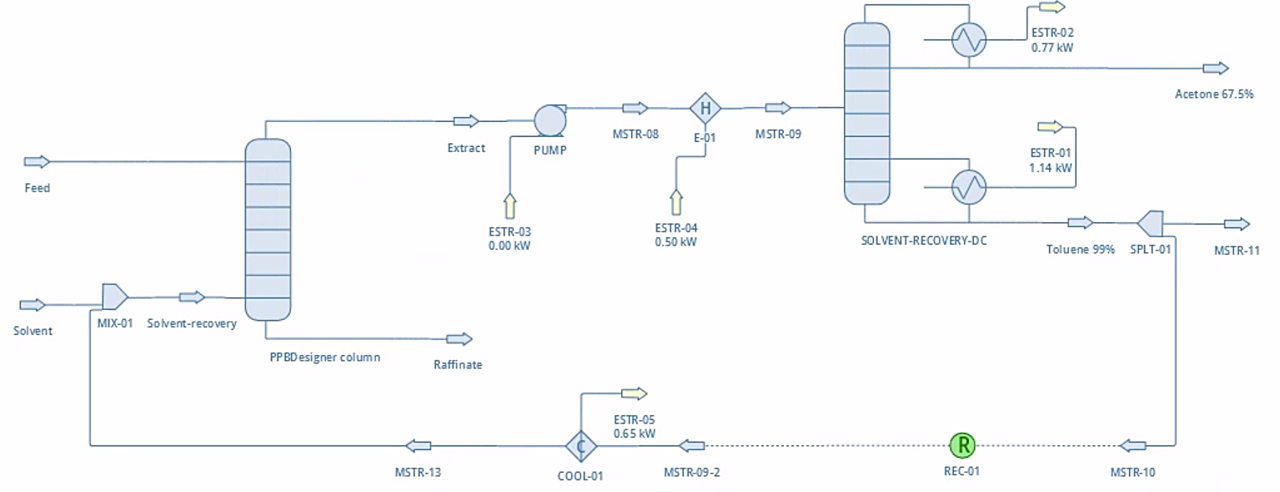
You can simulate a stand-alone column module or you can integrate PPBDesigner with other flowsheet modules for a complete chemical process flow diagram simulation.
It accesses simulator features such as thermodynamic property packages, sensitivity, and optimization tools.
Graphical visualization of the results, such as solute concentration, hold-up profile and Droplet Size Distribution (DSD), are generated automatically within the simulator.
PPBDesigner couples with Multivariate Sensitivity Study
Multivariate Sensitivity Study (MSS) enables the investigation of the effect of multiple input parameters on the simulation results. It is an application hosted on Simulate 365 DASHBOARD that enables the creation of sensitivity analysis and optimization scenarios for PPBDesigner column.
You simulate lab-scale or mini-plant unit and set up different scenarios with MSS focusing on sensitive parameters to meet the desired output requirements.
You adjust the model parameters to bring simulation results closed to the corresponding experimental data.
You solve an optimization problem in multi-dimensional space with various constrains and objectives faster.
MSS scenario example on Simulate 365 Dashboard for
RDC column simulated in PPBDesigner
Your column input parameters

Your column output parameters
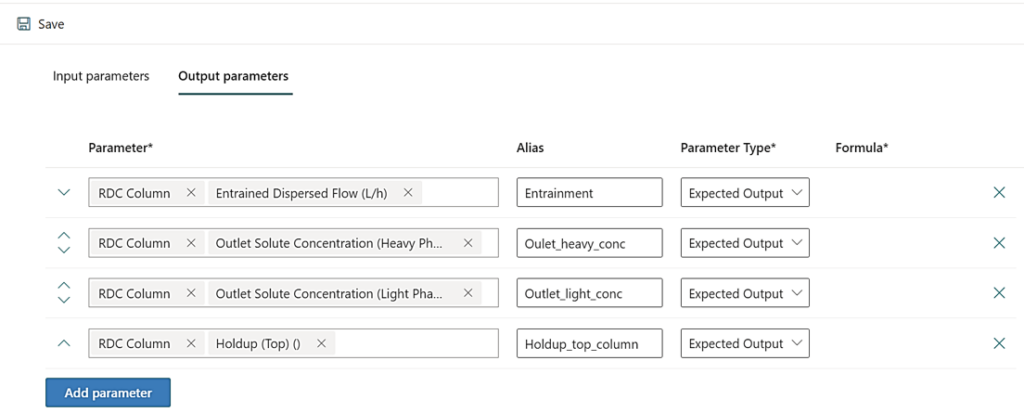
MSS results
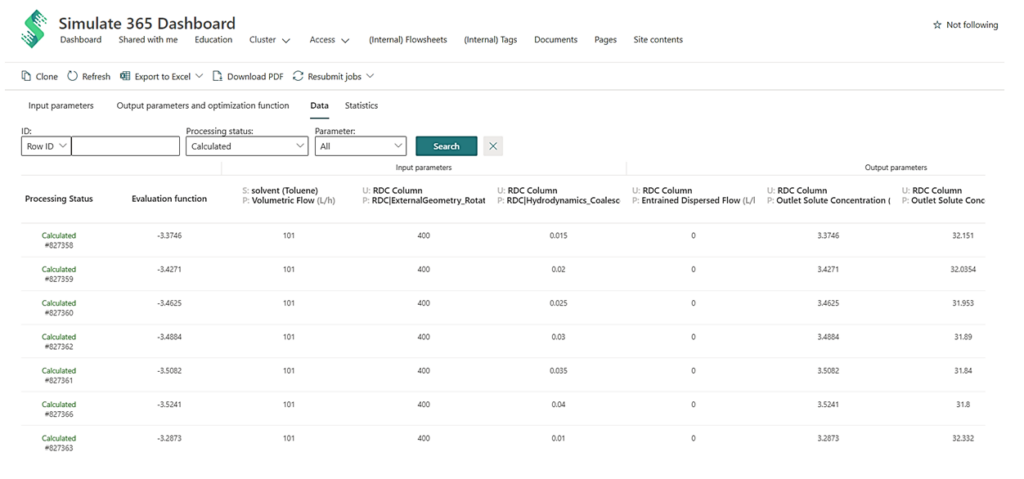
MSS statistics
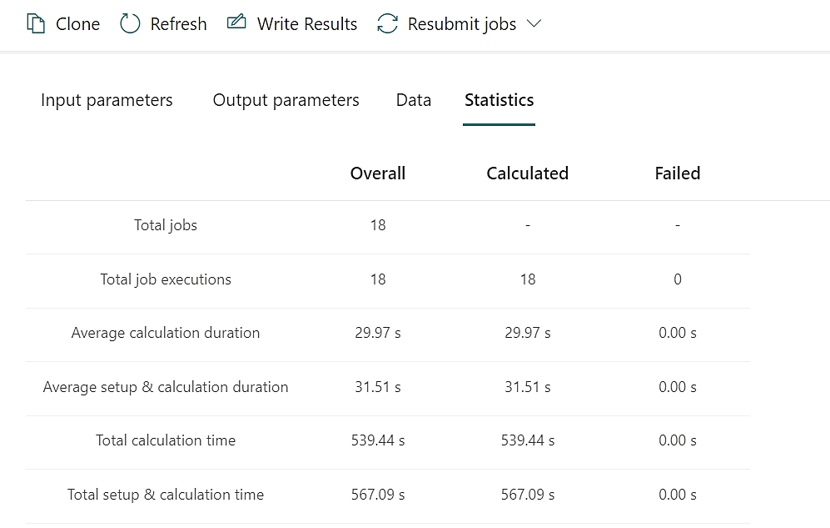
Hear what our users say
Get your free PPBDesigner trial
How PPBDesigner works
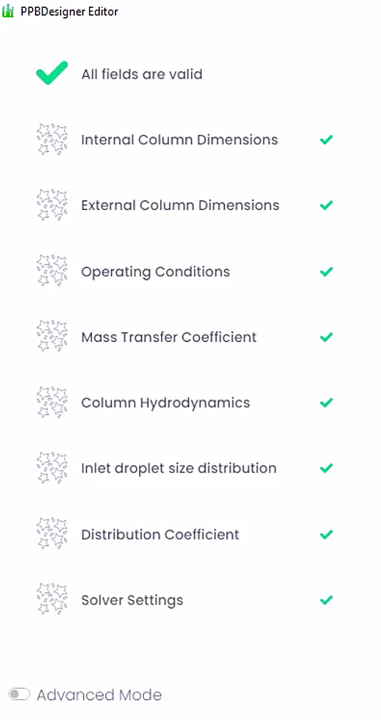
You define the column input parameters and select subpopulation balance models using the PPBDesigner Editor.
An automatic background check is performed to verify if all required user input is provided.
You start the simulation.
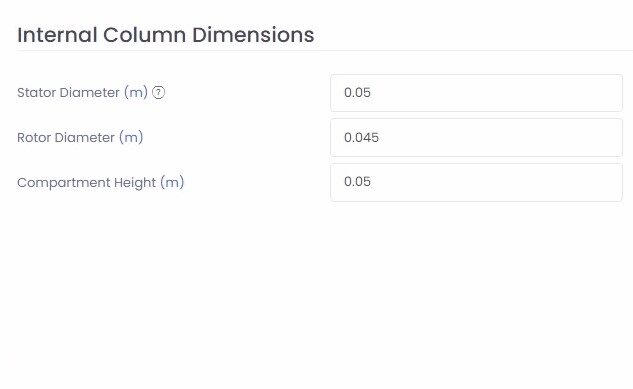
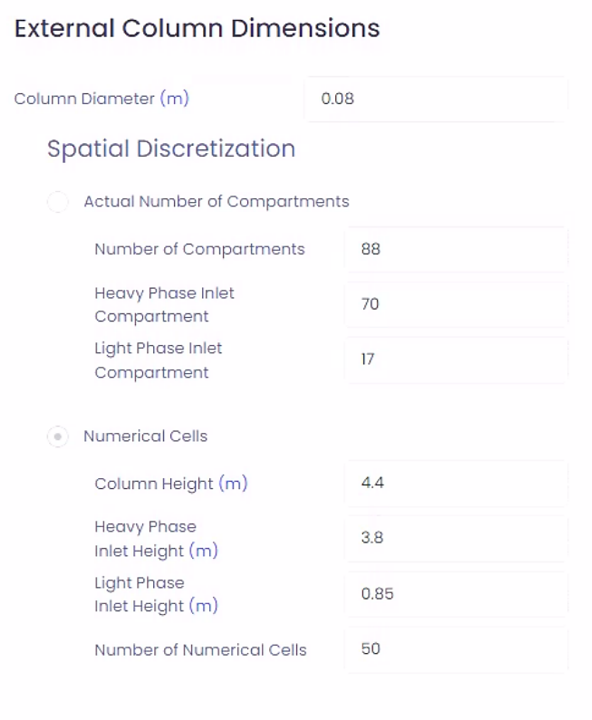
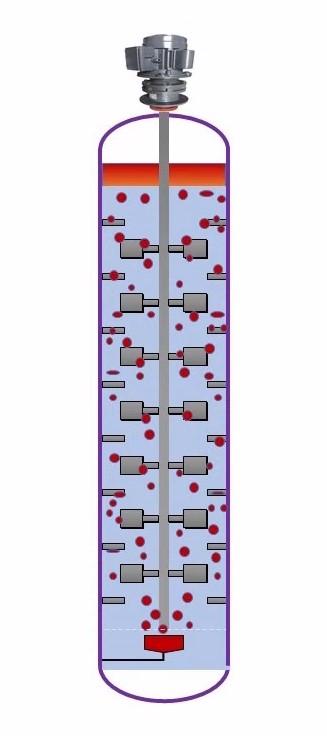
Simulation of a plant Rotating Disc Column (RDC) for extracting Acetone (Solute) from Water (aqueous phase) to Toluene (Organic phase).
Advanced Mode
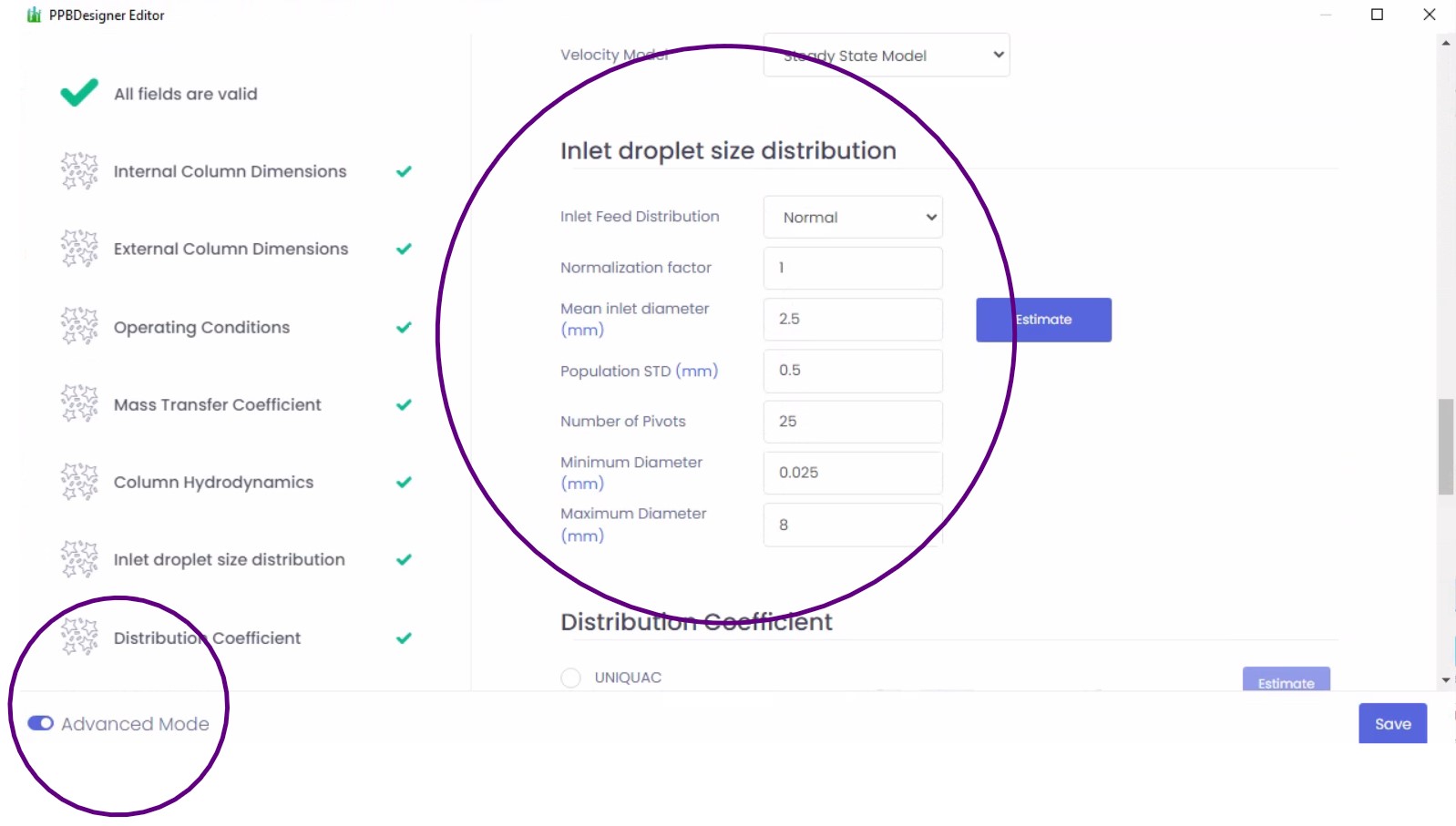
You can choose between standard and advanced modes for column design.
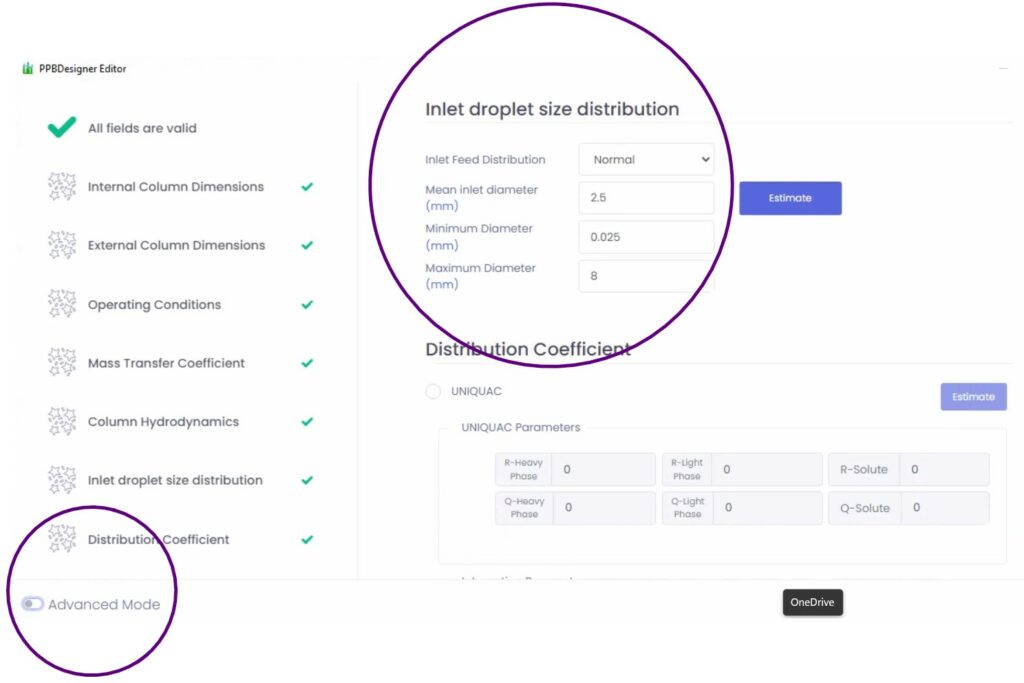
Standard Mode
Results View
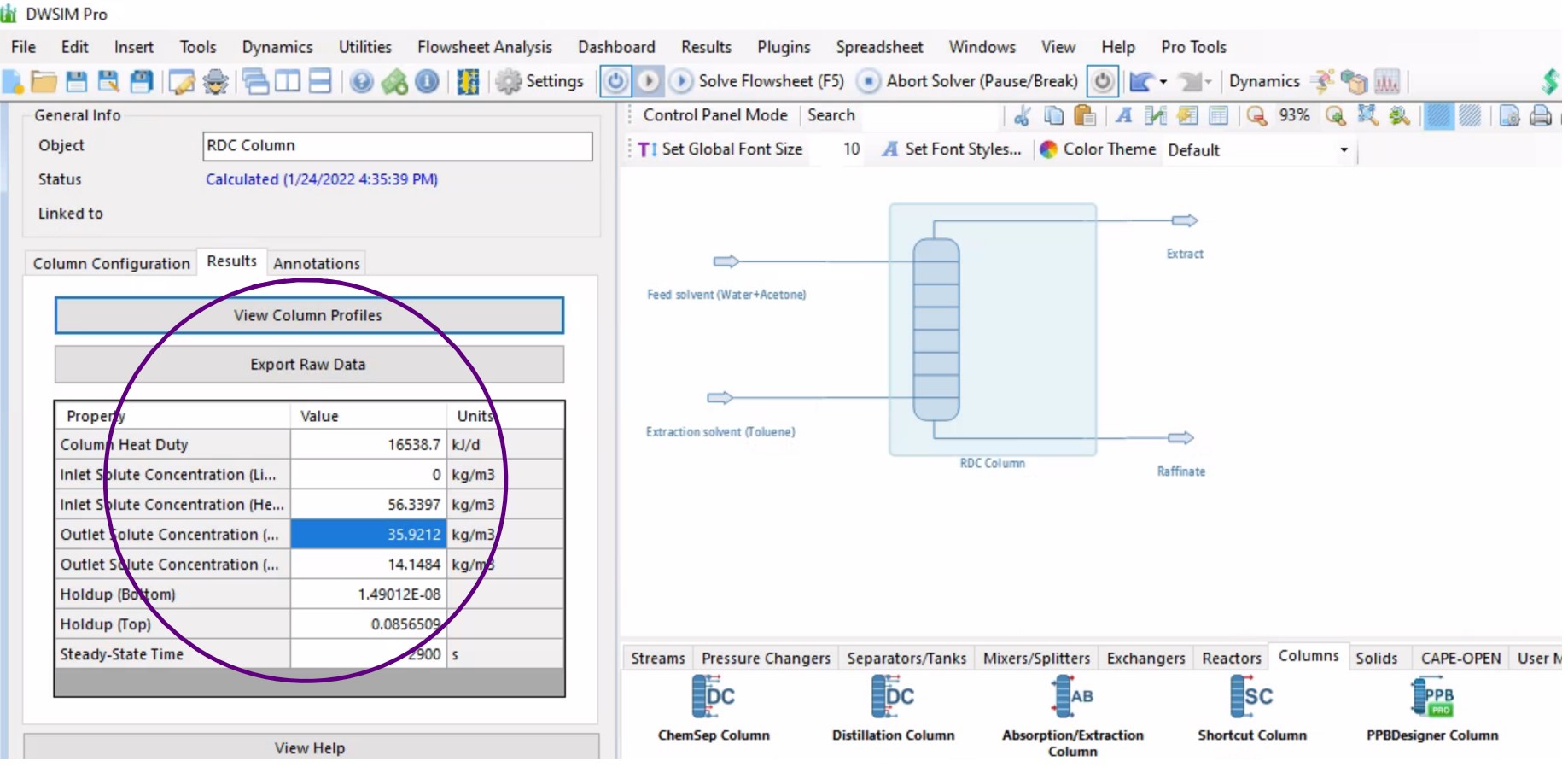
You can view the results in the simulation file.
You can access graphical and numerical displays of the simulation data and results in the PPBDesigner Editor.

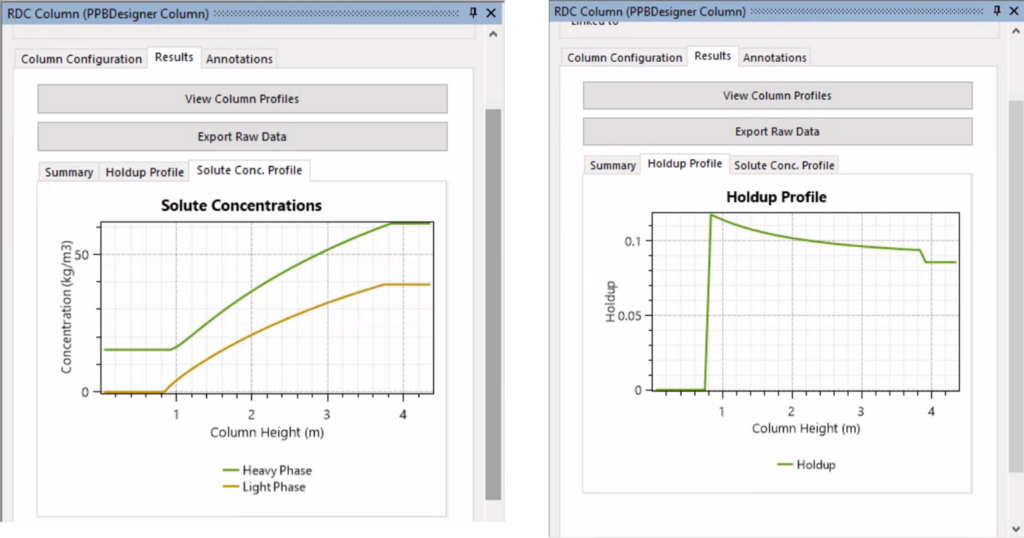
Extended Results View
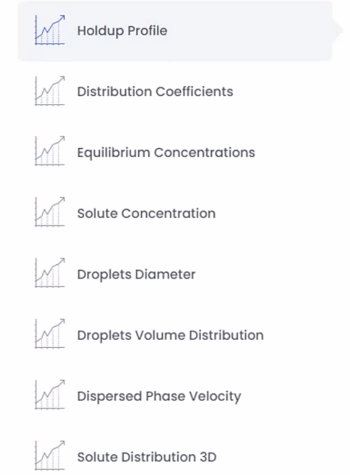
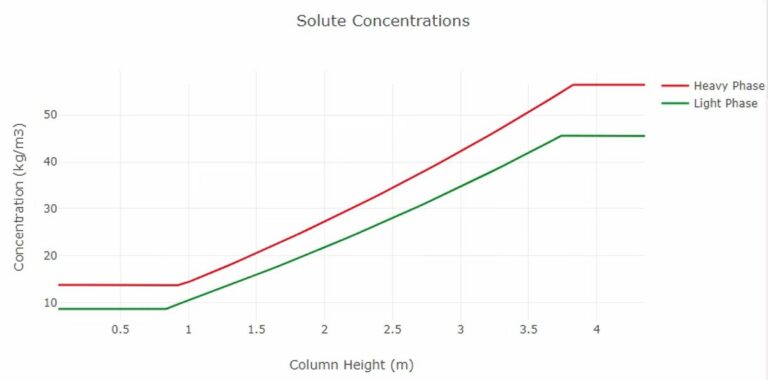
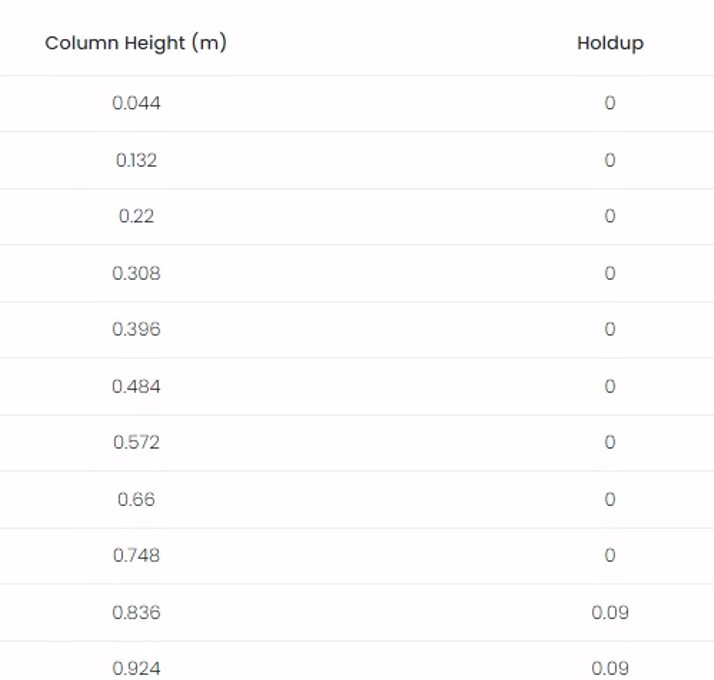
What else you should know
Due to the 1D CFD space solvers and the efficient and advanced population balance methods used, PPBDesigner excels in terms of computer memory usage and computational time compared to 2D and 3D CFD software (order of minutes versus order of weeks and months). The simulation results are found close to those of 2D and 3D CFD simulations.
The simulation results include the PPBDesigner learning algorithm. The column hydrodynamics is learnt in the first step and the column performance is validated in the prediction. The predicted simulation results are comparable with the experimental data published in the literature.

With sufficient phenomena details embedded into the PPBDesigner, its capability for scaling up liquid-liquid extraction columns is remarkable and reliable.
Meet the Expert
behind the Population Balance Modeling
Prof. Dr. Menwer Attarakih is a professor of Computer-aided Chemical Process Engineering and Industrial Mathematics and is currently the director of Accreditation & Quality Assurance Centre at and former Vice Dean for Quality Affairs & Accreditation/School of Engineering/University of Jordan.
As a guest professor at the Institute of Thermal Process Engineering, he spent regular research visits at the Institute of Process Engineering/University of Kaiserslautern/ Germany and Fraunhofer Institute for Industrial and Mathematical Economics during the summer of 2005 to the present.
He published more than 120 peer-reviewed papers and book chapters in well-known and reputable international Journals and participated in more than 50 peer-reviewed symposia and conferences.
He was honoured with the selection as a Testimonial in the Postgraduate & Doctoral Education by the International School for Graduate Studies (ISGS) at the University of Kaiserslautern/ Germany in 2008.
He was named and honoured as one of the top 10 percent of peer reviewers in Chemical Engineering in 2016 on Publons, where he is verified reviewer for the Chemical Engineering Science Journal, Chemical Engineering & Processing: Process Intensification Journal, Nuclear Engineering Journal, Journal of Computational Physics, Computers & Chemical Engineering Journal, Journal of Cleaner Production, the Chemical Engineering Research and Design Journals, and many more.
He is the Inventor of LLECMOD and PPBLab software for modelling and design of liquid-liquid extraction columns and SQMOM (US Patent 20100106467) as a discrete population balance framework to model discrete flow systems.
He invented and developed OPOSPM as a reduced population balance model which is used in the OPENFOAM Computational Fluid Dynamics (CFD) used by the open-source CFD toolkit OpenFOAM and is included in the release of OpenFOAM as multiphaseEulerFoam. Version 2.2.1. OPOSPM is used by Chemical Sciences and Engineering Division, Argonne National Laboratory, Argonne, IL 60439, USA to model centrifugal extractors to extract spent nuclear fuels.
He invented NQMOM a stable and reduced population balance solver which is implemented in the meshfree computational fluid dynamics software (FPM) of Fraunhofer Institute for Industrial and Mathematical Economics (ITWM)/Kaiserslautern/Germany. According to Reuters 2020, ITWM is ranked second worldwide as the top institution in scientific research and the number of inventions. (https://www.itwm.fraunhofer.de/en.html).
He developed CDA: A Conservative Discretization Method for discrete modelling and solution of Population Balances.
Developer of the Differential Maximum Entropy Method for solving Integral Population Balances.
Developer of the CQMOM, which recently solved the Moment Problem in Population Balances.
Worked on projects in modeling, troubleshooting, debottlenecking, design and operation with many leading international oil and petrochemical companies which include:
EDL Company in Leiptzeg/ Germany (http://www.edl.poerner.de/en.html).
SULZER Company/ Germany (http://www.sulzer.com/en/).
BASF/ Germany (http://www.basf.com/group/corporate/en/).
NOVARTIS/ Switzerland (http://www.novartis.com/).
Conference: 14th Mediterranean Congress of Chemical Engineering (MeCCE14)
- Attarakih, A. Fricke & H.-J. Bart (2020). PPBDesigner: A Population Balance Design Software for Particulate Systems, The 14th Mediterranean Congress of Chemical Engineering (MeCCE). 01- 04, December 2020, Fira Gran Vía, Barcelona, Spain, DOI: 10.48158/MeCCE-14.DG.06.03.
- Bart, H.-J., Jildeh, H., & Attarakih, M. (2020). Population Balances for Extraction Column Simulations-An Overview. Solvent Extraction and Ion Exchange, 38, 14-65.
- Attarakih, H.-J. Bart & M. Abu-Khader (2019). On the Solution of the Population Balance Equation: From Global to Local Constrained Maximum Entropy Method, Chemical Engineering Science, 209,115168, https://doi.org/10.1016/j.ces.2019.115168.
- Alzyod, M. Attarakih & H.-J. Bart (2018). CFD Modelling of Pulsed Sieve Liquid Extraction Columns using OPOSPM as a Reduced Population Balance Model: Hydrodynamics and Mass Transfer, Computer-Aided Chemical Engineering, 43, 451-456.
- Attarakih, S. Alzyod & A. Fricke (2017). Population Balance Modelling of pulsed packed bed extraction columns using PPBLab software, Computer-Aided Chemical Engineering, 40, 67-72.
- Alzyod, M. Attarakih & H.-J. Bart (2017). CFD Modelling of pulsed sieve plate liquid extraction columns using OPOSPM as a reduced population balance model, Computer-Aided Chemical Engineering, 40, 61-66.
- Alzyod, M. Attarakih, A. Hasseine & H.-J. Bart (2017). Steady state modeling of Kühni liquid extraction column using the Spatially Mixed Sectional Quadrature Method Of Moments (SM-SQMOM), Chem. Eng. Res. Design, 117C, 549-556.
- C. Korb, C., S. S. Alzyod, M. Attarakih, & H.-J. Bart (2017). SQMOM-Modellierung der Hydrodynamik in Kühni-Kolonnen bei der Reaktivextraktion, Chemie Ingenieur Technik, 89, 1-12.
- S. Alzyod,, C. Korb, C., M. Attarakih, & H.-J. Bart (2017). Steady state population balance modelling of Zink extraction in a Kuhni liquid-liquid extraction column ISEC2017- The 21st International Solvent Extraction Conference. 05-09-11, Miyazaki, Japan.
- Alzyod, M. Attarakih & H.-J. Bart (2016). Dynamic modelling of Kühni liquid extraction columns using the sectional quadrature method of moments (SQMOM), Comp. Chem. Eng., 94, 331-342.
- Attarakih, A. Hasseine & H.-J. Bart (2016). Modelling of an RDC extraction column using the differential maximum entropy method (DMaxEntM), Proceedings of International Conference on Materials & Energy (ICOM’16), 17-20 May 2016, La Rochelle, France.
- Alzyod, M. Attarakih, H-J. Bart, (2016), Detailed Modeling of an RDC liquid extraction column using the Sectional Quadrature Method Of Moments (SQMOM), Proceedings of young researchers symposium (YRS), Fraunhofer Verlag, Kaiserslautern, 9-14.
- Attarakih , S. Alzyod & H.-J. Bart (2016). A new population balance module for pulsed sieve plate liquid extraction column using PPBLab software, 22nd International Congress of Chemical and Process Engineering, CHISA 2016 Prague, Czech Republic, 28-31 August, 2016.
- M Attarakih, M Hlawitschka, M Abu-Khader, S Al-Zyod, HJ Bart (2015). CFD-Population Balance Modelling and Simulation of Coupled Hydrodynamics and Mass Transfer in Liquid Extraction Columns. Applied Mathematical Modelling, 39, 5105-5120.
- W Hlawitschka, M. Attarakih, S. Al-Zyod & H.-J. Bart (2015). CFD based extraction column design – Chances and challenges. Chinese Journal of Chemical Engineering, 24, 259-263, 10.1016/j.cjche.2015.07.023.
- Attarakih, AlZyod, S. Hlawitschka, M. and Bart, H.-J. (2015): OPOSSIM: A population balance-SIMULINK module for modelling coupled hydrodynamics and mass transfer in liquid extraction equipment, Computer-Aided Chemical Engineering, 37, 257-262.
- Attarakih, S. S. Al-Zyod, A. Hasseine and H.-J. Bart (2015). Population Balance Modelling of Pulsed Packed Bed Extraction Column using PPBLab, 10th European Congress on Chemical Engineering, 27 September – 01 August 2015, Nice, France, ISBN , 978-2-910239-82-4.
- Alzyod S., M. Attarakih, Dutta A., Bart H-J., (2015). The Sectional Quadrature Method Of Moments (SQMOM): An application to liquid-liquid extraction columns. Mathematics in (Bio)Chemical Kinetics and Engineering MaCKiE, 02-03.07.2015, Ghent, Belgium.
- Jildeh, F. Gebauer, M. Mickler, M. Attarakih, H.-J. Bart (2015). Influence of inlet droplet size distribution on column hydrodynamics. Jahrestreffen der Fachgruppen Extraktion und Mischvorgänge, 16.-17.03.2015, Heidelberg, Germany.
- B. Jildeh, M. Attarakih, H.-J. Bart (2014). Modelling approach to estimate droplet Interaction parameters, Proceedings of ISEC2014, 7-11-Sep. 2014, Wuerzberg, Germany.
- Jildeh, H. B., Attarakih, M. & Bart, H.-J. (2014). Parameter optimisation and validation for droplet population balances. Canadian Journal of Chemical Engineering, 92, 2010-219.
- Mickler, M., Jildeh, H. B., Attarakih, M. & Bart, H. J. (2014). Online monitoring, simulation and prediction of multiphase flows. Canadian Journal of Chemical Engineering, 92, 307–317.
- Attarakih, Albaraghthi, T., Abu-Khader, M., Al-Hamamre, Z. & Bart, H.-J. (2012). Mathematical modeling of high- pressure oil-splitting reactor using a reduced population balance model. Chemical Engineering Science, 84, 276–291.
- Jildeh, H. B., Attarakih, M. & Bart, H.-J. R. (2013). Droplet coalescence model optimization using a detailed population balance model for RDC extraction column. Chemical Engineering Research and Design, 91, 1317-1326.
- Attarakih, M., Al-Zyod, S., Abu-Khader, M. & Bart, H. J. (2012). PPBLAB: A new multivariate population balance environment for particulate system modelling and simulation. Procedia Engineering, 42, 1574-1591.
- Jaradat, M. Attarakih and H.-J. Bart (2012). RDC Extraction column simulation using the Multiprimary One Secondary Particle Method: Coupled Hydrodynamics and Mass Transfer, Computers & Chemical Engineering, 37, 22-32.
- Jaradat, M. Attarakih, T. Steinmetz & H.-J. Bart (2012). LLECMOD: A bivariate Population Balance Tool for Pulsed Liquid-Liquid Extraction Columns, The Open Chemical Engineering Journal, 6, 8-31.
- Jaradat, M. Attarakih & H.-J. Bart (2012). Population Balance Modeling of Pulsed (Packed and Sieve-Plate) Extraction Columns: Coupled Hydrodynamic and Mass Transfer, Ind. Eng. Chem. Res., 50,14121–14135.
- M. Attarakih, (2010). System and method for simulating and modeling the distribution of discrete systems, United States Patent Application: US20100106467A1, April 29, 2010.
- Jaradat, M. Attarakih and H.-J. Bart (2011). Advanced Prediction of Pulsed (Packed and Sieve) Extraction Column Performance using Population Balance Modeling, Chem. Eng. Res. Design J., 89, 2752–2760.
- Mickler, S. Didas, M. Jaradat, M. Attarakih, H.-J. Bart (2011).Tropfenschwarmanalytik mittels Bildverarbeitung zur Simulation von Extraktionskolonnen mit Populationsbilanzen, Chem. Ing. Tech.,(83), 226-237.
- Drumm, M. M. Attarakih, M. W. Hlawitschk and H.-J. Bart (2010). A one-group reduced population balance model for CFD simulation of a pilot-plant extraction column. Ind. Eng. Chem. Res., 49 (7), 3442–3451.
- Jaradat, M. M. Attarakih and H.-J. Bart (2010): Effect of Phase Dispersion and Mass Transfer Direction on Steady State RDC Performance. Chemical Engineering Journal, 165 (2), 379-387.
- M. Attarakih, C. Drumm, H.-J. Bart & N. M. Faqir, (2009). Solution of the population balance equation using the sectional quadrature method of moments (SQMOM). Chemical Engineering Science, 64, 742–752.
- Drumm, M. M Attarakih and H.-J. Bart, (2009). Coupling of CFD with DPBM for an RDC extractor. Chemical Engineering Science, 64, 721 – 732.
- M. Attarakih, H.-J. Bart, T. Steinmetz, M. Dietzen & N. M. Faqir (2008). LLECMOD: A Bivariate Population Balance Simulation Tool for Liquid-Liquid Extraction Columns. The Open Chemical Engineering Journal, 2, 2008, 10-34.
- Drumm, S. Tiwari, M.M. Attarakih, J. Kuhnert, H.-J. Bart (2008): CFD –PBM coupled model using finite pointset method and SQMOM, in: Solvent Extraction: Fundamentals to Ind. Applications, B.M. Moyer( Ed.), 1177-1182, Can. Inst. Min. Met., Montreal.
- M. Attarakih, Bart, H.-J., & Faqir, N. M. (2006). Numerical solution of the bivariate population balance equation for interacting hydrodynamics and mass transfer in liquid-liquid extraction columns. Chem. Eng. Sci., 61, 113- 123.
- Schmidt, A. S., Simon, M., Attarakih, M. M., Lagar, L. G. & Bart, H.-J. (2006). Droplet Population Balance Modelling: Hydrodynamics and Mass Transfer. Chem. Eng. Sci., 61, 246-256.
- M., Attarakih, Bart, H.-J., & Faqir, N. M. (2006). LLECMOD: A windows-based program for hydrodynamics simulation of liquid-liquid extraction columns. Chem. Eng. Procc., 45, 113-123.
- M. Attarakih, Bart, H. J., & Faqir, N. M. (2004). Solution of the droplet breakage equation for interacting liquid-liquid dispersions: A conservative discretization approach. Chem. Eng. Sci., 59, 2547-2565.
- M. Attarakih, Bart, H.-J. & Faqir, N. M. (2004). Numerical solution of the spatially distributed population balance equation describing the hydrodynamics of interacting liquid-liquid dispersions. Chem. Eng. Sci. 59, 2567-2592.
- B. Jildeh, Menwer Attarakih, Matthias Mickler & Hans-Jörg Bart (2012). An Online Inverse Problem for the Simulation of Extraction Columns using Population Balances, Computer Aided Process Engineering, 30, 1043–1047.
- M. Attarakih, H. B. Jildeh, M. Mickler & H.J. Bart (2012). The OPOSPM as a Nonlinear Autocorrelation Population Balance Model for Dynamic Simulation of Liquid Extraction Columns, Computer-Aided Process Engineering, 31, 1216-1220..
- Jaradat, M. M. Attarakih, M. Hlawitschkah and H.-J. Bart (2011). Detailed Mathematical Modelling of Liquid-Liquid Extraction Columns. Computer Aided Chemical Engineering, Vol. 29, pp. 1-5.
- Hlawitschkah, M. Jaradat, M. M. Attarakih, H.-J. Bart and J. Kuhnert (2011). A CFD-Population Balance Model for the Simulation of Kuehni Extraction Column. Computer Aided Chemical Engineering, Vol. 29, pp. 66-70.
- M. Attarakih, M. Jaradat, H. Allaboun, H.-J. Bart & N. M. Faqir (2008). Dynamic Modelling of a Rotating Disk Contactor Using the Primary and Secondary Particle Method (PSPM). Proc. Of the 18th European Symposium on Computer-Aided Process Engineering (ESCAPE 18), Linon/ France, June 2008.
- W. Hlawitschka1, Jildeh, H. B., Attarakih, M. M., Al-Zyoud, S. & Bart, H.-J. (2014). Computer Aided Simulation of Liquid-liquid Extraction Columns , 20th International Solvent Extraction Conference 2014, 7–11 September 2014, Würzburg, Germany.
- Attarakih, Hlawitschka, M. W., Al-Zyod, S., Abu-Khader, M., Bart, H.-J (2013). A Hyperbolic Population Balance Model for Dynamic Analysis of Liquid Extraction Columns, Proceedings of the 6th International Conference on Process Systems Engineering (PSE ASIA) 25 – 27 June 2013, Kuala Lumpur.
- -J. Bart, Hlawitschka, M. W. & Attarakih, M. & (2013). Mass transfer and Population Balance Modeling using 3D-CFD, Proceedings of the 5th International Conference on Population Balance Modelling, 11-13 Sep., Bangalore, India.
- Jaradat, M. Attarakih and H.-J. Bart (2011). Advanced Prediction of Pulsed Extraction Column Performance using LLECMOD, (CM)2-Young Researcher Symposium Proceedings: 22-27, 15 February 2011, Kaiserslautern-Deutschland.
- B. Jildeh, M. Attarakih and H.-J. Bart (2011). An Inverse Problem Method for RDC Simulation, (CM)2-Young Researcher Symposium Proceedings: 45-49, 15 February 2011, Kaiserslautern-Deutschland.
- M. Attarakih, M. Jaradat, M. Hlawitschkah, H.-J. Bart and J. Kuhnert (2010). Solution of the population balance equation using the Cumulative Quadrature Method Of Moments (CQMOM). 4th International Conference on Population Balance Modelling hosted by the Max Plank Institute for Dynamics of Complex Technical Systems, 15-17.09.2010, Berlin, Germany.
- Kuhnert, M. Attarakih, S. Tiwari, M. Hlawitschka, H.-J. Bart(2010). Finite Pointset Method (FPM): Meshfree numerical solution of Population Balance Equations, The 16-th European Conference on Mathematics for Industry, July 26-30, 2010 Wuppertal, Germany.
- Jaradat, M. Attarakih, M. Hlawitschka and H.-J. Bart (2010). A multivariate population balance model for liquid extraction columns. 4th International Conference on Population Balance Modelling hosted by the Max Plank Institute for Dynamics of Complex Technical Systems, 15-17.09.2010, Berlin, Germany.
- M. Hlawitschka, C. Drumm, M. Attarakih, H.-J. Bart (2010). Simulation of a Kühni extraction column using a CFD and population balance model. 4th International Conference on Population Balance Modelling hosted by the Max Plank Institute for Dynamics of Complex Technical Systems, 15-17.09.2010, Berlin, Germany.
- M. Attarakih, H. Allaboun, C. Drumm, H.-J. Bart, S. Tiwari & J. Kuhnert (2008). Dynamic Modelling of Liquid-Liquid Extraction Columns using the Direct Primary Secondary Particle Method (DPSPM). Proc. of the 6th International Conference on CFD in Oil & Gas, Metallurgical and Process Industries, SINTEF/NTNU, Trondheim Norway,10-12 June 2008.
- Tiwari, C. Drumm, V. K. Sharma, J. Kuhnert, M. Attarakih, A. Klar and H.-J., Bart (2008). A Meshfree CFD-Population Balance Equation Coupled Model, Proc. Of the 6th International Conference on CFD in Oil & Gas, Metallurgical and Process Industries, SINTEF/NTNU, Trondheim Norway,10-12 June 2008.
- Steinmetz, T., Schmidt, S., Attarakih, M. & H.-J. Bart (2005). Droplet Population Balancing for Column Simulation. International Solvent Extraction Conference, Proc. Of ISEC ’05, CD-ROM (ISBN 7-900692-02-9), China Acad. J. Electronic Publ. House, isec2005.org.ch.
- Bart, H-J., Schmidt, S. & Attarakih, M. (2005). Advanced Column Modelling for Reactive Extraction. The 8th conference on Process Integration, Modelling and Optimization for Energy Saving and Polution Reduction. Klemes, J. (Ed). Chemical Engineering Transactions (7), 297-302.
- M. Attarakih, H.-J. Bart, N.M. Faqir (2004). Numerical solution of the bivariate population balance equation for interacting hydrodynamics and mass transfer in liquid-liquid extraction columns. Proc. Of the 2nd Int. Conf. on Population Balance Modelling, 5./7.5.2004, Valencia, Spain, 94-97, J. Nopoens, K. Malisse, C.A. Biggs, J.J. Dcoste (eds.) EUROSIS, Ghent, Belgium.
- A. Schmidt, M. Simon, M. M. Attarakih, L. Lagar Garcia, H.-J. Bart (2004). Estimation of Populance Parameters in Liquid-Liquid Extraction Column. Proc. Of the 2nd Int. Conf. on Population Balance Modelling, 5./7.5.2004, Valencia, Spain,55-58, J. Nopoens, K. Malisse, C.A. Biggs, J. J. Dcoste (eds.) EUROSIS, Ghent, Belgium.


